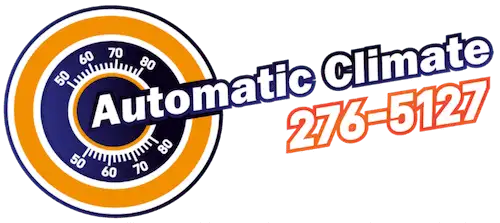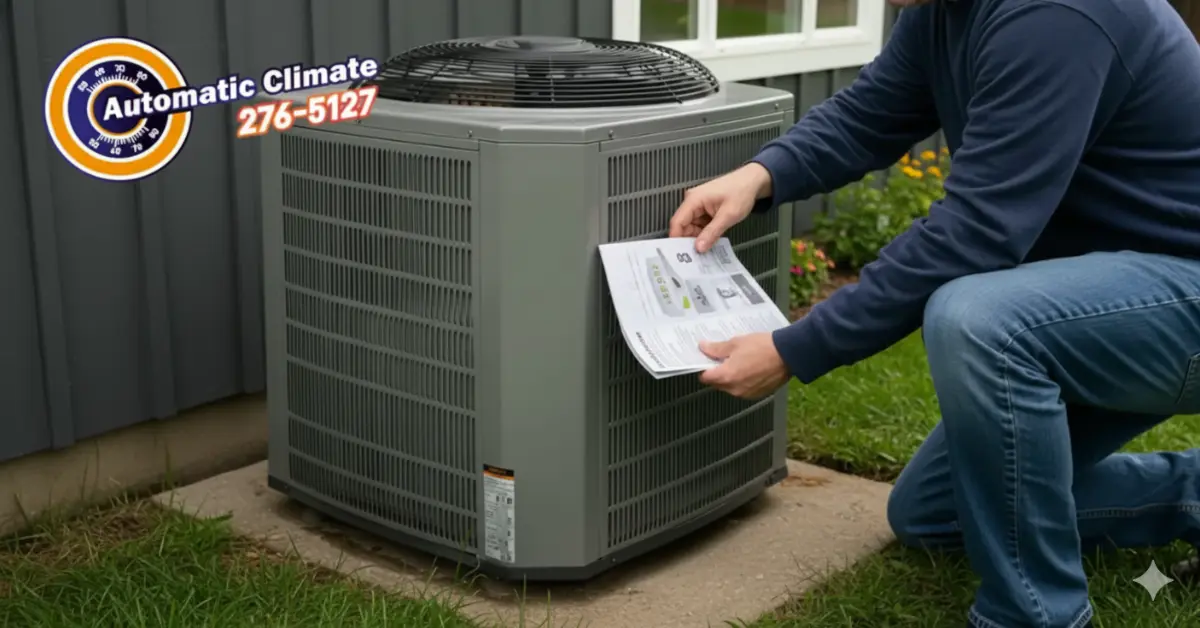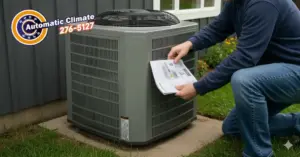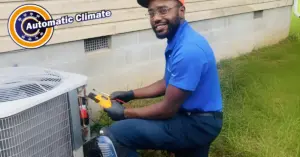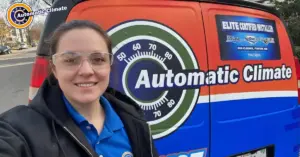5 Telltale Signs It’s Time to Replace Your Old Furnace
Written by Cole Summers at Automatic Climate in Richmond, Virginia.
Are you seeing the signs to replace your furnace? It’s a question we get alot here in Richmond, especially when that first real cold snap hits. Your furnace is that silent workhorse you never think about… until it stops working. And a cold house in the middle of a Virginia winter is nobody’s idea of fun. My name is Cole Summers, and I’m with Automatic Climate. We’ve been keeping Richmond families warm since 1983, so we’ve seen just about every furnace problem you can imagine. We know it’s tough to decide whether to get another heating repair or finally bite the bullet and replace your old furnace. It’s a big decision. But often, your furnace will give you warnings. You just have to know what to look for.
Ignoring these warnings can lead to more than just a chilly morning; it can mean higher bills, uncomfortable drafts, and even serious safety risks for your family. As Benjamin Franklin famously said, “An ounce of prevention is worth a pound of cure.” This is especially true for your home’s heating system. Waiting for a complete breakdown is the most expensive and stressful way to find out you need to replace your old furnace. This article is your guide to understanding the five biggest signs to replace your furnace, helping you make a smart, informed decision *before* you’re left in the cold. We’ll explore why a new furnace installation might be the best investment you make in your home this year.
The 5 Big Signs You Need to Watch For
They’re are clues your system gives off. Sometimes they are loud and obvious. Sometimes they’re quiet. Here are the top signs to replace your furnace that we see every day in the Richmond area.
1. Your Furnace is How Old?! (The Age Factor)
This is the big one. If your furnace was in your home when you moved in, do you even know how old it is? Like any major appliance, furnaces have a limited lifespan. A well-maintained furnace can last about 15 to 20 years. Some older, heavy-duty models might push 25, but they are running on borrowed time. If your furnace is in that 15+ year range, it’s not a question of *if* it will fail, but *when*. You could keep paying for a furnace repair, but you’re sinking money into a system that’s on its way out. Age is probably the number one reason people start looking for a new furnace installation. As Forbes Home points out, furnaces from the 1990s or earlier might have an AFUE (Annual Fuel Utilization Efficiency) of just 60-70%. Modern units are 95% efficient or more. If your furnace is old enough to vote, it’s definitely time to start budgeting to replace your old furnace.
Think about it: technology from 20 years ago seems ancient, right? Your furnace is no different. Continuing to repair an old, inefficient unit is like trying to use a flip phone in a smartphone world. It works, but it’s costing you in ways you don’t even realize. This is one of the clearest signs to replace your furnace, even if it hasn’t broken down *yet*.
2. Your Energy Bills are Through the Roof
Are you getting sticker shock every time you open your gas or electric bill in the winter? Does it seem to creep up year after year, even if your habits haven’t changed? That’s not just inflation; it’s your furnace. As furnaces age, they lose their efficiency. Parts wear out, they have to run longer and work harder to produce the same amount of heat. That extra runtime translates directly into higher utility bills. You might be paying for a new furnace installation right now, you’re just paying for it in small, painful chunks to your utility company—without even getting the new furnace! A new, high-efficiency system can cut your heating costs significantly, often enough that the new system pays for itself over its lifespan. The Department of Energy has extensive resources showing how much you can save by upgrading. If your bills are climbing, it’s one of the most painful signs to replace your furnace. Your wallet will thank you for it’s new, efficient friend.
3. Constant Repairs (The Money Pit)
We see this all the time. A homeowner calls us for a furnace repair. Then, six months later, they call us for a different repair. And again in the fall. Are you on a first-name basis with our heating services team? We love our customers, but we don’t want to see you *that* often! A breakdown here or there is normal. But when repairs become a regular event, your furnace is telling you something. It’s failing. There’s a rule of thumb in the HVAC industry: if the cost of a furnace repair is 50% or more of the cost to replace your old furnace, replacement is the obvious financial choice. But even smaller, frequent repairs add up. You’re throwing good money after bad. That money you’re spending on patches and temporary fixes could be a down payment on a reliable, efficient new system. If you have “HVAC repair” as a line item in your monthly budget, that’s one of the loudest signs to replace your furnace.
4. Strange Noises and Smells
Your furnace should be relatively quiet. You’ll hear it kick on and the gentle hum of the blower. But you should *not* hear banging, popping, rattling, or squealing. These sounds are not “just your house settling.”
- Banging or Popping: This could be dirty burners causing a small, contained explosion on ignition. It can also be your ductwork expanding and contracting, but if it’s new, it’s a concern.
- Squealing or Whining: This often points to a problem with the blower motor, a belt, or a bearing.
- Rattling: Could be a loose panel, or it could be something more serious, like a failing motor.
- Grinding: This is a bad one. It’s often a sign of a shot bearing in the motor. Shut the system down and call a professional.
Smells are just as bad. A dusty, burning smell when you first turn it on for the season is normal. But a persistent burning smell, a smell of melting plastic or rubber, or a “hot” metallic smell is a major red flag. This Old House notes that new, strange sounds are clear indicators of a problem. These are urgent signs to replace your furnace—or at least get it inspected immediately. Don’t just turn up the TV; listen to what your furnace is telling you.
5. Your Home Feels… Wrong (Uneven Heating & Poor Air Quality)
Does your home have “that one room” that’s always freezing? Do you have to bundle up in the living room but sweat in the bedroom? That’s a sign your furnace is no longer able to distribute heat effectively. As furnaces age, their motors weaken, and they struggle to push the right amount of air through your entire duct system. This leads to hot and cold spots all over the house. You’re paying to heat your *whole* home, not just parts of it. This is a comfort issue, but it’s also a clear signal of a failing system. It’s one of the signs to replace your furnace that you can *feel*.
Even worse is the air quality. An old, failing furnace can be a major source of indoor air pollution. If you notice more dust, soot, or dirt building up around your vents, that’s a problem. A cracked heat exchanger (which we’ll talk about later) can leak carbon monoxide. Does the air in your home feel excessively dry? Does your family seem to suffer from more allergies, asthma, or respiratory issues in the winter? Your old furnace could be the culprit, circulating dust, dander, and mold spores. When you’re thinking about whether to replace your old furnace, think about your family’s health. A new furnace installation, especially when paired with our indoor air quality solutions, can make your home healthier *and* more comfortable. Don’t ignore these vital signs to replace your furnace.
Info Chart: The Repair vs. Replace Decision Guide
CONSIDER A FURNACE REPAIR IF…
- It’s Young: The furnace is less than 10-12 years old.
- It’s a Minor Fix: The issue is a simple, low-cost part (like a sensor, ignitor, or thermostat).
- Bills are Stable: Your energy bills haven’t been climbing steadily.
- It’s a First-Time Offense: This is the first major repair it has needed in years.
- You Have a Warranty: The part that failed is still covered under the manufacturer’s warranty.
CONSIDER FURNACE REPLACEMENT IF…
- It’s Old: The furnace is 15+ years old (this is one of the biggest signs to replace your furnace).
- Repairs are Costly: The repair bill is 50% or more of a new unit’s cost.
- It’s a Frequent Flyer: You’re paying for furnace repair multiple times a year.
- Bills are High: Your utility costs are skyrocketing.
- It’s Unsafe: It has a cracked heat exchanger or major safety issue.
- It’s Noisy & Uneven: The system is loud and can’t keep your home comfortable.
Sources: Information compiled from industry best practices and guides from Consumer Reports and Angi.
Beyond the Signs: The *Why* Behind Replacing Your Old Furnace
Okay, so you’ve seen the signs to replace your furnace. Your old unit is noisy, expensive, and ancient. But what’s the real benefit of a new furnace installation? It’s not just about getting “a new box that makes heat.” It’s about upgrading your home’s entire comfort system. Technology has come a *long* way. As the writer Christian Lous Lange said, “Technology is a useful servant but a dangerous master.” In this case, letting old, dangerous technology rule your home is a mistake. Embracing new, servant-like technology is the solution.
The Magic of AFUE: Unlocking Real Energy Savings
I mentioned AFUE before, but let’s really dig in. AFUE stands for Annual Fuel Utilization Efficiency. It’s a percentage that tells you how much of the fuel your furnace consumes is actually converted into heat for your home. The rest is wasted up the chimney. That 20-year-old furnace? It might have an AFUE of 70%. That means for every dollar you spend on fuel, 30 cents is literally going up in smoke. Today, the minimum standard AFUE for new furnaces is 80%, and most high-efficiency condensing furnaces we install at Automatic Climate are 95% or higher. That’s 95 cents of every dollar warming your family. This isn’t a small change. This is a massive leap in efficiency. When you replace your old furnace, you’re not just stopping the problems; you’re gaining a powerful new tool for saving money every single month. These savings alone are one of the best reasons to stop getting a furnace repair and start planning for a replacement.
A Quieter, More Comfortable Home
Remember those bangs, squeals, and rattles? A new furnace installation changes the entire soundscape of your home. Modern furnaces are designed for quiet operation. They have variable-speed motors that ramp up and down gently, instead of the “all-or-nothing” blast of old units. This also means better, more even heat. A variable-speed blower can run at a low speed almost continuously, circulating the air, eliminating hot and cold spots, and filtering your air 24/7. This is a level of comfort your old furnace just can’t provide. If you’re tired of hearing your furnace kick on from two rooms away, the peace and quiet of a new system is a huge, often overlooked, benefit. It’s one of the signs to replace your furnace you might not see, but you can definitely *hear* (or not hear, in this case).
Peace of Mind: The Safety Factor
This is the most important reason of all. The most dangerous part of an old gas furnace is the heat exchanger. This is the metal chamber where the gas burns to heat the air. Over 15 or 20 years of expanding and contracting with heat, this metal can develop cracks. They can be microscopic at first, but they are incredibly dangerous. Why? Because a cracked heat exchanger can leak Carbon Monoxide (CO)—a colorless, odorless, deadly gas—directly into your home’s airstream. This is not a “maybe” situation; it’s a “get this fixed now” situation. Often, a cracked heat exchanger is not a furnace repair; it’s an automatic reason to replace your old furnace. Your family’s safety is non-negotiable. The Red Cross urges all homes with fuel-burning appliances to have CO detectors, but the first line of defense is a safe, properly functioning furnace. If your system is old, a safety inspection from one of our professionally trained technicians is critical. Don’t wait for the signs to replace your furnace to become a tragedy.
A new furnace installation also means new safety sensors, new wiring, and a system that’s built to modern safety codes. You can’t put a price on knowing your family is safe and warm. This peace of mind is the biggest return on your investment. If you’re seeing any of the other signs to replace your furnace, the safety issue should be what seals the deal. It’s time to replace your old furnace.
Pro Maintenance Tips to Extend Your *Next* Furnace’s Life
Protecting Your Investment
As Malcolm X said, “The future belongs to those who prepare for it today.” Prepare your furnace for the future.
1. Change Your Filter (Religiously!)
This is the #1 easiest thing you can do. A clogged filter makes your furnace (and your AC) work harder, restricting airflow, increasing bills, and shortening its life. Check it monthly and change it every 1-3 months, depending on your filter type and home (pets, allergies, etc.).
2. Keep Vents and Registers Clear
Don’t block your supply or return air vents with furniture, rugs, or drapes. Your system is designed for a specific amount of airflow; blocking it creates pressure imbalances and makes the system struggle. This can lead to overheating and a furnace repair.
3. Schedule Annual Professional Tune-Ups
This is crucial. Our Gas Furnace Tune-Up is a comprehensive safety and performance check. Our professionally trained technicians clean burners and flame sensors, inspect the heat exchanger, test safety controls, and optimize the system for efficiency. This prevents breakdowns and catches problems (like CO leaks) before they become dangerous. Check out our Heating Maintenance Agreements to make it easy.
4. Listen and Look
You’re now an expert on the signs to replace your furnace. Use that knowledge! If you hear new noises or see soot or rust around the unit, don’t wait. Call us. Early detection is the key to a simple furnace repair instead of a premature replacement.
Sources: Automatic Climate service protocols and HGTV home maintenance guides.
What Really Happens During a New Furnace Installation?
The idea of a new furnace installation can be intimidating. It sounds big, messy, and expensive. But at Automatic Climate, we’ve refined the process over our decades in business (since 1983!) to be as smooth and respectful of your home as possible. Once you’ve recognized the signs to replace your furnace and decided to move forward, here’s what you can expect.
Step 1: The Consultation & Sizing
First, one of our comfort advisors will visit your home. This is *not* a high-pressure sales pitch. Our goal is to find the *right* solution for you. We’ll listen to your concerns (those cold spots, the high bills), inspect your current system, and measure your home. We perform calculations (like a Manual J load calculation) to determine the exact size furnace your home needs. This is critical! A furnace that’s too big (short-cycling) or too small (always running) is inefficient and will fail early. We’ll present you with options and a clear, upfront estimate. We don’t do pricing games, just honest advice. This is the most important step in the new furnace installation process.
Step 2: Prepping Your Home
On installation day, our professionally trained technicians will arrive ready to work. We treat your home like it’s our own. We lay down drop cloths and wear protective covers on our boots to keep your floors clean. We’ll confirm the scope of work with you before we begin, so you know exactly what’s happening. We want you to feel comfortable and confident from start to finish. We do not offer emergency service, but we do schedule our installations promptly and efficiently to get you up and running as soon as possible.
Step 3: Removing the Old, In with the New
This is the main event. We’ll safely disconnect and dismantle your old furnace. We’ll haul it away for you, so you don’t have to worry about disposal. Then, we begin the new furnace installation. This involves setting the new unit, making sure it’s perfectly level, and connecting the ductwork, fuel line, and electrical. We pay meticulous attention to detail, ensuring all connections are sealed tight. A leaky duct connection is a major source of energy loss, and we make sure it’s done right. This is also the perfect time to consider your ductwork. If you’ve seen the signs to replace your furnace, your ducts might be just as old. We can inspect them and, if needed, perform our Rotobrush air duct cleaning service. We don’t use high-pressure machines that can damage ducts; our patented Rotobrush system spins to dislodge debris while its HEPA vacuum captures it. It’s the perfect complement to a new furnace installation, ensuring you’re not blowing old dust through your new system.
Step 4: Testing, Testing, and More Testing
Once everything is connected, we don’t just flip a switch and leave. We initiate the furnace’s startup sequence and run it through a comprehensive checklist. We test safety sensors, check gas pressure, measure airflow, and test the thermostat. We make sure the furnace is combusting properly and safely. We’ll walk you through the operation of your new system and thermostat, answering any questions you have. We don’t leave until we’re 100% confident your new system is operating perfectly and you’re 100% comfortable using it. This thorough commissioning is what separates a professional job from a sloppy one. After you replace your old furnace, you should have total peace of mind.
The whole process to replace your old furnace typically takes a single day. You’ll start the morning with an old, inefficient unit and end the day with a quiet, safe, and powerful new heating system. It’s a transformative upgrade for your home, and we’re proud to be the team that Richmond trusts to do it right.
Seeing the Signs? Don’t Wait for a Breakdown!
If you’re seeing any of these signs to replace your furnace, don’t ignore them. A failing furnace is a problem that only gets worse. Contact the professionally trained team at Automatic Climate today for a hassle-free, no-pressure consultation.
Get Your Free EstimateCase Study: The Johnson Family’s Richmond Home
The Problem: A “Haunted” Furnace
The Johnsons, in a 1990s home in the West End, were fed up. Their 22-year-old gas furnace was making loud banging noises, their energy bills were astronomical, and their upstairs bedrooms were “like iceboxes.” They had paid for two different furnace repair visits in the last 18 months. They were seeing all the signs to replace their furnace but were worried about the cost and hassle of a new furnace installation.
The Solution: A Modern System from Automatic Climate
Our team performed a full inspection. We confirmed their old unit was running at about 65% AFUE and the loud bang was a delayed ignition (a safety hazard). We presented them with options for a new, 96% AFUE two-stage, variable-speed furnace. After seeing the clear math on energy savings and the safety concerns, they decided it was time to replace their old furnace. Our team handled the installation in one day, including sealing some leaky joints in their ductwork.
The Result: Quiet, Efficient, and Safe
Mrs. Johnson called us a month later, after the first cold spell. She said the house was “unbelievably quiet” and, for the first time, her upstairs bedrooms were comfortable. Their first full winter heating bill was 35% lower than the previous year. They had peace of mind knowing their home was safe and were thrilled with the comfort and savings. Their only regret? Not calling us sooner when they first saw the signs to replace their furnace.
Sources: This case study is based on common scenarios and customer feedback received by Automatic Climate, as detailed in our customer reviews.
The Hidden Dangers of Ignoring the Signs to Replace Your Furnace
It’s easy to procrastinate. “The furnace is making noise, but it’s still making heat.” “The bills are high, but maybe next month will be better.” We get it. Nobody *wants* to deal with a new furnace installation. But ignoring the signs to replace your furnace isn’t just a gamble on your comfort; it’s a gamble on your safety and your finances. Thomas Edison once said, “I have not failed. I’ve just found 10,000 ways that won’t work.” Your old furnace has found all the ways to *not* work efficiently, and it’s time to stop letting it fail. Let’s talk about the real risks of waiting too long to replace your old furnace.
The #1 Risk: Carbon Monoxide
We’ve said it before, and we’ll say it again. This is the single biggest danger. A cracked heat exchanger in an old furnace is a silent killer. Because CO is odorless and invisible, you may not know you have a leak until it’s too late. Symptoms of CO poisoning mimic the flu: headaches, dizziness, nausea, and confusion. If your furnace is old and you’re experiencing these symptoms, get to fresh air *immediately* and call for help. A furnace repair can’t fix a cracked heat exchanger; it demands you replace your old furnace. No amount of savings is worth this risk. This is the most serious of all the signs to replace your furnace.
The “Breakdown” Tax: Paying More for Waiting
Furnaces love to die at the worst possible time—during the first, coldest night of the year. Why? Because that’s when they are under the most strain. When your furnace fails completely, you’re in a terrible spot. You’re cold, you’re stressed, and you have to make a fast decision. You don’t have time to research. You’re at the mercy of whoever can get to you the fastest. This is when you’re most likely to overpay or get a system that isn’t right for your home. By acting when you first see the signs to replace your furnace, you are in control. You can take your time, get a proper consultation (like our free estimates), and make a smart choice. Planning a new furnace installation in the fall is infinitely better than scrambling for one in a January blizzard.
Cascading Failures: Harming Your Other Systems
Your furnace doesn’t work in a vacuum. It shares a critical component with your air conditioning system: the blower motor. If your old furnace has a failing, inefficient blower, it’s *also* making your AC system work harder in the summer. This can lead to premature failure of your AC unit as well. Furthermore, a furnace that’s creating a lot of soot or dust is clogging your AC’s evaporator coil, which is a very expensive furnace repair (or AC repair). A new furnace installation can actually improve the performance and lifespan of your air conditioner. It’s all one interconnected system. Ignoring the signs to replace your furnace can create a domino effect of expensive problems. The decision to replace your old furnace is an investment in your entire HVAC system.
The bottom line is that the signs to replace your furnace are not suggestions; they are warnings. Your home is telling you that a critical system is reaching the end of its life. Listening and acting proactively saves you money, keeps you safe, and guarantees your comfort. Don’t wait for the signs to turn into a full-blown emergency.
Frequently Asked Questions About Furnace Replacement
1. How long does a furnace really last?
As we covered, most modern furnaces last 15-20 years. As Good Housekeeping confirms, regular maintenance is key to hitting that 20-year mark. If yours is over 15, you should be planning for a replacement.
2. What are the main signs to replace your furnace?
The 5 big ones are: 1) It’s 15+ years old, 2) Your energy bills are rising, 3) You need frequent repairs, 4) It’s making strange noises or smells, and 5) Your home is unevenly heated or dusty.
3. How long does a new furnace installation take?
In most cases, a standard new furnace installation can be completed by our professionally trained technicians in just one day.
4. Is it worth getting a furnace repair on an old unit?
It depends. If the furnace repair is minor (under $300) and the furnace is under 12-15 years, it can make sense. But if the repair is costly (over 50% of replacement) or the unit is 15+ years old, you’re usually better off putting that money toward a new system.
5. What does AFUE mean?
AFUE (Annual Fuel Utilization Efficiency) is a percentage rating. A 95% AFUE furnace converts 95% of its fuel to heat, wasting only 5%. An old 70% AFUE furnace wastes 30% of its fuel. Upgrading is a major energy saver.
6. Do I need to replace my air conditioner at the same time?
You don’t *have* to, but it’s often a good idea. Your furnace and AC share the same blower. Matching them as a “system” ensures maximum efficiency. If your AC is also old, replacing both at once is more cost-effective and ensures both components are perfectly matched.
7. What’s the danger of a cracked heat exchanger?
This is the most critical reason to replace your old furnace. A crack can leak deadly, odorless Carbon Monoxide (CO) into your home’s air. It’s a non-negotiable safety hazard.
8. Do you offer emergency service?
We do not offer 24/7 or emergency service. We are an appointment-based company focused on providing high-quality, scheduled installations and heating repairs during our regular business hours. This focus allows our team to be thorough and dedicated to every job.
9. Are your technicians NATE-certified?
Our technicians are not NATE-certified. They are Professionally Trained Technicians who undergo continuous, rigorous in-house and factory training to stay on top of the latest technology and service standards. We stand by the quality of our team’s expertise.
10. Why are my energy bills so high?
A: An aging, inefficient furnace is a primary cause. As parts wear, the furnace runs longer to produce the same heat, burning more fuel. This is one of the clearest financial signs to replace your furnace.
11. What are variable-speed and two-stage furnaces?
These are modern, high-efficiency features. A two-stage furnace has a “low” and “high” setting, so it can run at a lower, more efficient level most of the time. A variable-speed blower adjusts its speed for ultimate comfort and quietness. They’re a big upgrade from old “on/off” systems.
12. Will a new furnace help my allergies?
Yes! A new furnace installation, especially one with a variable-speed blower and a high-MERV filter, does a much better job of cleaning your air. It circulates and filters more air, removing dust, pollen, and dander. It’s a great part of an indoor air quality solution.
13. Do I need my ducts cleaned when I replace my furnace?
It’s the absolute best time to do it. You don’t want to push years of built-up dust and debris through your brand new system. Our Rotobrush air duct cleaning service ensures your entire system is clean from day one.
14. What about a heat pump? Is that better than a furnace?
It can be! A heat pump installation is an all-electric system that both heats and cools your home. They are incredibly efficient, especially in Virginia’s climate. We’d be happy to discuss if a heat pump or a gas furnace is the right choice for you.
15. Do you offer financing?
Yes, we offer flexible financing options to make your new furnace installation manageable for your budget. You can learn more and even make a payment on our website.
16. Why is my furnace making a loud banging noise?
This is often delayed ignition—gas builds up before it lights, causing a mini-explosion. It’s a serious furnace repair issue and a clear sign your system is unsafe and needs inspection immediately.
17. What’s included in your heating tune-up?
Our Gas Furnace Tune-Up is comprehensive: we conduct a safety inspection (checking for gas leaks and CO risks), clean burners and flame sensors, inspect the heat exchanger and blower, test the ignition and thermostat, and check/replace client-provided filters.
18. Why is my home so dusty?
It could be leaky ducts, but it’s often your old furnace. A failing system with a weak blower and poor filtration just circulates dust instead of capturing it. This is one of the top “comfort” signs to replace your furnace.
19. Do you have maintenance plans?
Yes! Our Heating Maintenance Agreements are the best way to protect your new investment. They include annual tune-ups, discounts on repairs, and priority service.
20. How do I get a free estimate?
That’s the easy part! Just give us a call at (804) 803-1983 or fill out the contact form on our website. We’ll schedule a no-pressure consultation at your convenience.
Sources: Article content and expertise from Automatic Climate, plus external data from The Family Handyman.
Additional Resources & Further Reading
For more information on furnace safety, efficiency, and replacement, we recommend these national resources:
- U.S. Dept. of Energy: Furnaces and Boilers
- Consumer Reports: When to Replace a Furnace
- This Old House: Know When to Replace the Furnace
- Bob Vila: 7 Signs You Need Furnace Replacement
- Forbes Home: How Long Does a Furnace Last?
- Good Housekeeping: How Long Do Furnaces Last?
- Angi: 7 Signs It’s Time for a Furnace Replacement
- HGTV: Know When to Replace Your Furnace
- The Family Handyman: 12 Signs You Need a New Furnace
- American Red Cross: Carbon Monoxide Poisoning Prevention
#HVAC #FurnaceReplacement #RichmondVA #AutomaticClimate #HomeHeating #EnergyEfficiency #SignsToReplaceFurnace #HVACRepair #HomeMaintenance #RVA #HeatingServices
Legal Disclaimer:
This article was drafted with the assistance of a Large Language Model, specifically Gemini, which was used for initial drafting and article outlining. The content was subsequently reviewed, edited, and fact-checked by a human writer to ensure accuracy, clarity, and adherence to editorial standards. While AI assists in the creation of this content, the human author(s) retain editorial control and full responsibility for the final content, including its accuracy and integrity. Readers should be aware that AI-generated content may present limitations, and the information provided should be considered with this in mind.
The information provided in this article is for general informational purposes only. While we strive to keep the information up-to-date and correct, we make no representations or warranties of any kind, express or implied, about the completeness, accuracy, reliability, suitability, or availability with respect to the 1 article or the information, products, services, or related graphics contained in the article for any purpose. Any reliance you place on such information is therefore strictly at your own risk. 2 HVAC systems involve electrical components, refrigerant, and potentially natural gas; attempting repairs without proper training and safety precautions can result in injury, property damage, or voiding warranties. Always consult with a qualified and licensed HVAC professional, like those at Automatic Climate (https://www.automaticclimate.com/, (804) 803-1983), for diagnosis and repair of HVAC issues.
